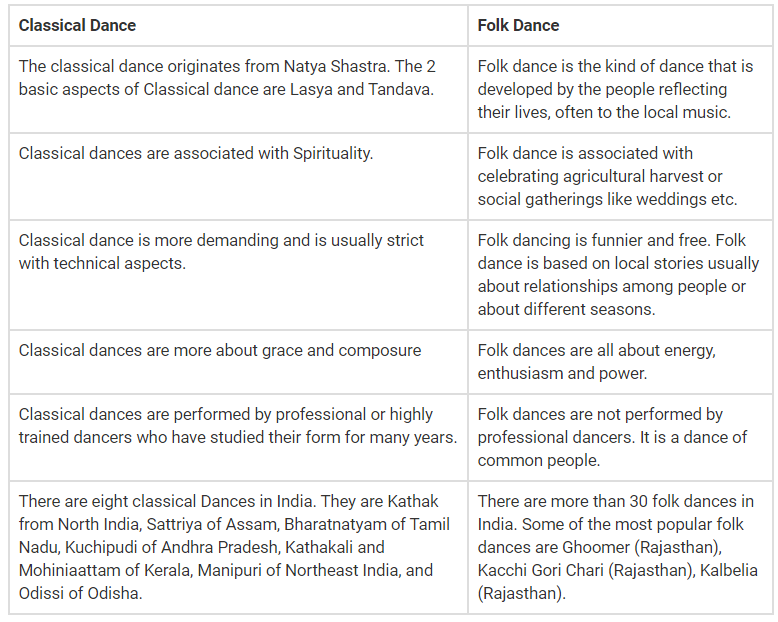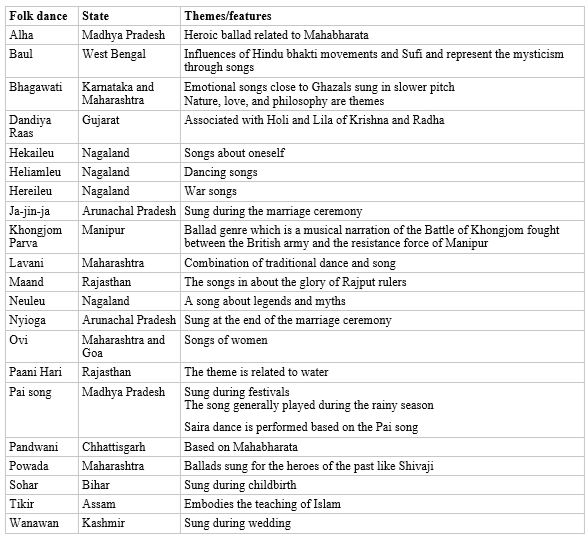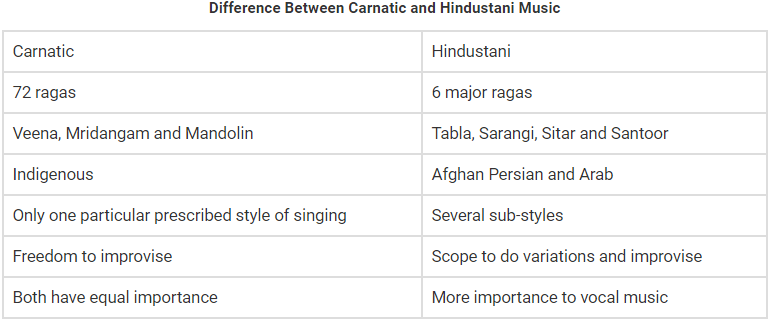The Jan 22nd Static Quiz on Art and Culture (Indian Music)
Quiz-summary
0 of 10 questions completed
Questions:
- 1
- 2
- 3
- 4
- 5
- 6
- 7
- 8
- 9
- 10
Information
The Jan 22nd Static Quiz on Art and Culture (Indian Music)
You have already completed the quiz before. Hence you can not start it again.
Quiz is loading...
You must sign in or sign up to start the quiz.
You have to finish following quiz, to start this quiz:
Results
0 of 10 questions answered correctly
Your time:
Time has elapsed
You have reached 0 of 0 points, (0)
Categories
- Not categorized 0%
- 1
- 2
- 3
- 4
- 5
- 6
- 7
- 8
- 9
- 10
- Answered
- Review
- Question 1 of 10
1. Question
Which of the following are the difference between Folk and Classical Music are correct?
1. Folk dances are associated with Spirituality.
2. Classical dances are all about energy, enthusiasm and power.
3. Folk dances are more about grace and composureCorrectAns;- d) None of the above
Explanation;-
• All are incorrectly matched
About Classical and Folk Dance
• The 2 major dance forms in India are classical and folk dance and the major difference between both these dances is their origin. Classical dance has a deep-rooted relationship with the Natya Shastra. Folk dance, on the other hand, emerged from the local tradition of the respective state, ethnic or geographic regions.
 Incorrect
IncorrectAns;- d) None of the above
Explanation;-
• All are incorrectly matched
About Classical and Folk Dance
• The 2 major dance forms in India are classical and folk dance and the major difference between both these dances is their origin. Classical dance has a deep-rooted relationship with the Natya Shastra. Folk dance, on the other hand, emerged from the local tradition of the respective state, ethnic or geographic regions.

- Question 2 of 10
2. Question
Which of the following folk music are correctly matched with respect to their states?
State Folk Music Name
1. Baul = West Bengal
2. Alha = Madhya Pradesh
3. Bhagawati = KarnatakaCorrectAns;- d) All of the above
Explanation;-
• India is a geographically and traditionally diverse country.
• There are 28 states and 8 Union Territories (U.T.) bonded under the spirit of nationalism.
• There are several differences between Classical music and folk music.
• The classical music follows the rules laid in the Natya Shastra and cultivates the Guru-Shisya tradition where folk music tradition is the music that has no hard rules.
• Folk music is primarily based on diverse themes and full of brisk rhythm.
• They are also set on beats so they can be dance-oriented.
• There are different types of folk music associated with a specific state. Incorrect
IncorrectAns;- d) All of the above
Explanation;-
• India is a geographically and traditionally diverse country.
• There are 28 states and 8 Union Territories (U.T.) bonded under the spirit of nationalism.
• There are several differences between Classical music and folk music.
• The classical music follows the rules laid in the Natya Shastra and cultivates the Guru-Shisya tradition where folk music tradition is the music that has no hard rules.
• Folk music is primarily based on diverse themes and full of brisk rhythm.
• They are also set on beats so they can be dance-oriented.
• There are different types of folk music associated with a specific state.
- Question 3 of 10
3. Question
Which of the following statements about Indian Music are correct?
1. The history of Indian music can be derived from Natya Shastra, written by Bharatha Muni, a
Musicologist.
2. It is believed that Indian music was more or less uniform till the 13th century but later bifurcated into
two musical systemsCorrectAns;- c) Both 1 and 2
Explantion;-
• Both the statements are correct about Indian Music• Natyasastra of Bharata which is supposed to have been written sometime between 2nd century B.C and 2nd century A.D is a landmark in the history of Indian music.
• It has several chapters that have formed the basis for the development of Indian music.
• It is believed that Indian music was more or less uniform till the 13th century but later bifurcated into two musical systems i.e. Hindustani and Carnatic.IncorrectAns;- c) Both 1 and 2
Explantion;-
• Both the statements are correct about Indian Music• Natyasastra of Bharata which is supposed to have been written sometime between 2nd century B.C and 2nd century A.D is a landmark in the history of Indian music.
• It has several chapters that have formed the basis for the development of Indian music.
• It is believed that Indian music was more or less uniform till the 13th century but later bifurcated into two musical systems i.e. Hindustani and Carnatic. - Question 4 of 10
4. Question
Which of the following statements about Hindustani Music are correct?
1. The Hindustani music originated in North India in the 13th and 14th century.
2. The Hindustani music has elements of ancient Hindu tradition, Vedic philosophy and Persian tradition as well. It is based on Raga system.
3. Hindustani Music is music centric.CorrectAns;- a) Only 1 and 2
Explanation;-
• The 3rd statement is incorrect because it is vocal centric.
About Hindustani Music
• The Hindustani music originated in North India in the 13th and 14th century.
• The Hindustani music has elements of ancient Hindu tradition, Vedic philosophy and Persian tradition as well.
• It is based on Raga system. The Raga is a melodic scale comprising of basic seven notes.
• Hindustani Music is vocal-centric.
• The major vocal forms associated with Hindustani classical music are the khayal, Ghazal, dhrupad, dhammar, tarana and thumri.IncorrectAns;- a) Only 1 and 2
Explanation;-
• The 3rd statement is incorrect because it is vocal centric.
About Hindustani Music
• The Hindustani music originated in North India in the 13th and 14th century.
• The Hindustani music has elements of ancient Hindu tradition, Vedic philosophy and Persian tradition as well.
• It is based on Raga system. The Raga is a melodic scale comprising of basic seven notes.
• Hindustani Music is vocal-centric.
• The major vocal forms associated with Hindustani classical music are the khayal, Ghazal, dhrupad, dhammar, tarana and thumri. - Question 5 of 10
5. Question
Which of the following statements about Carnatic Music are correct?
1. Carnatic music which denotes “traditional” or “codified” music.
2. Carnatic Sangeet has developed in the south Indian states of Tamil Nadu, Kerala, Andhra Pradesh and Karnataka.
3. These states are known for their strong presentation of Nagara culture.CorrectAns;- a) Only 1 and 2
Explanation;-
• The 3rd statement is incorrect because it represents Dravidian Style.About Carnatic Music
• Carnatic music owes its name to the Sanskrit term Karnâtaka Sangîtam which denotes “traditional” or “codified” music.
• Composed of a system of Ragam (Raga) and Thalam (Tala), it has a rich history and tradition.
• Carnatic Sangeet has developed in the south Indian states of Tamil Nadu, Kerala, Andhra Pradesh and Karnataka.
• These states are known for their strong presentation of Dravidian culture.IncorrectAns;- a) Only 1 and 2
Explanation;-
• The 3rd statement is incorrect because it represents Dravidian Style.About Carnatic Music
• Carnatic music owes its name to the Sanskrit term Karnâtaka Sangîtam which denotes “traditional” or “codified” music.
• Composed of a system of Ragam (Raga) and Thalam (Tala), it has a rich history and tradition.
• Carnatic Sangeet has developed in the south Indian states of Tamil Nadu, Kerala, Andhra Pradesh and Karnataka.
• These states are known for their strong presentation of Dravidian culture. - Question 6 of 10
6. Question
The oldest form of composition of Hindustani Vocal Music is:
CorrectAns;- b) Dhrupad
Explanation;-
The Hindustani music system uses different musical forms like Dhrupad, Khyal etc.,
The Dhrupad is considered as one of the oldest forms of Hindustani vocal music.IncorrectAns;- b) Dhrupad
Explanation;-
The Hindustani music system uses different musical forms like Dhrupad, Khyal etc.,
The Dhrupad is considered as one of the oldest forms of Hindustani vocal music. - Question 7 of 10
7. Question
Which of the following are the correct Differnce between Hindustani and Carnatic Music?
1. Both the Carnatic and Hindustani styles give principal prominence to the melody.
2. Hindustani importance to vocal music
3. Only one particular prescribed style of singing in Hindustani musicCorrectAns;- a) Only 1 and 2
Explanation;-
• The 3rd statement is incorrect because it is Carnatic music
 Incorrect
IncorrectAns;- a) Only 1 and 2
Explanation;-
• The 3rd statement is incorrect because it is Carnatic music

- Question 8 of 10
8. Question
Chakyar Koothu is a performing art associated with which of the following states?
CorrectAns;- b) Kerala
Explanation;-
• Chakyar Koothu is a performance art from Kerala, South India. It is primarily a type of highly refined monologue where the performer narrates episodes from Hindu epics (such as the Ramayana and the Mahabharata) and stories from the Puranas. Sometimes, however, it is also a traditional equivalent of the modern stand-up comedy act, incorporating commentary on current socio-political events (and personal comments directed at the members of the audience).
IncorrectAns;- b) Kerala
Explanation;-
• Chakyar Koothu is a performance art from Kerala, South India. It is primarily a type of highly refined monologue where the performer narrates episodes from Hindu epics (such as the Ramayana and the Mahabharata) and stories from the Puranas. Sometimes, however, it is also a traditional equivalent of the modern stand-up comedy act, incorporating commentary on current socio-political events (and personal comments directed at the members of the audience).
- Question 9 of 10
9. Question
Ans;- b) Kerala
Explanation;-
• Chakyar Koothu is a performance art from Kerala, South India. It is primarily a type of highly refined monologue where the performer narrates episodes from Hindu epics (such as the Ramayana and the Mahabharata) and stories from the Puranas. Sometimes, however, it is also a traditional equivalent of the modern stand-up comedy act, incorporating commentary on current socio-political events (and personal comments directed at the members of the audience).
With reference to Dhrupad, consider the following statements:
1. Dhrupad originated and developed in the Rajput kingdoms during the Mughal period.
2. Dhrupad is primarily a devotional and spiritual music.
3. Dhrupad also uses Sanskrit syllables from mantras.Select the correct answer using the codes given below:
CorrectAns;- b) Only 2 and 3
Explanation;-
• Dhrupad is the Indian classic music that traces its origin to the chanting of vedic hymns and mantras. It is also primarily a form of worship, in which offerings are made to the divine through sound. Statement 2 is correct thus.
• The earliest source that mentions a musical genre called Dhrupad is Ain-i-Akbari of Abu Fazl . Dhrupad had mainly thrived under patronage of Rajput and Mughal Period till 17th century. So therefore, statement 1 is wrong as it says Dhrupad ‘originated’ under them.
• Dhrupad is performed in two parts- Alap and Bandish. In the Alap, the singer uses syllables from Sanskrit Mantras. Therefore statement 3 is correct.
• Thus, statement 2 and 3 are correct.IncorrectAns;- b) Only 2 and 3
Explanation;-
• Dhrupad is the Indian classic music that traces its origin to the chanting of vedic hymns and mantras. It is also primarily a form of worship, in which offerings are made to the divine through sound. Statement 2 is correct thus.
• The earliest source that mentions a musical genre called Dhrupad is Ain-i-Akbari of Abu Fazl . Dhrupad had mainly thrived under patronage of Rajput and Mughal Period till 17th century. So therefore, statement 1 is wrong as it says Dhrupad ‘originated’ under them.
• Dhrupad is performed in two parts- Alap and Bandish. In the Alap, the singer uses syllables from Sanskrit Mantras. Therefore statement 3 is correct.
• Thus, statement 2 and 3 are correct. - Question 10 of 10
10. Question
Which from the following is a “Classical” dance form?
CorrectAns;- b) Bharatanatyam
Explanation;-
• Bharatanatyam is a major genre of Indian classical dance that originated in the Hindu temples of Tamil Nadu and neighboring regions.
• Traditionally, Bharatanatyam has been a solo dance that was performed exclusively by women, and expressed Hindu religious themes and spiritual ideas, particularly of Shaivism, but also of Vaishnavism and Shaktism.IncorrectAns;- b) Bharatanatyam
Explanation;-
• Bharatanatyam is a major genre of Indian classical dance that originated in the Hindu temples of Tamil Nadu and neighboring regions.
• Traditionally, Bharatanatyam has been a solo dance that was performed exclusively by women, and expressed Hindu religious themes and spiritual ideas, particularly of Shaivism, but also of Vaishnavism and Shaktism.






